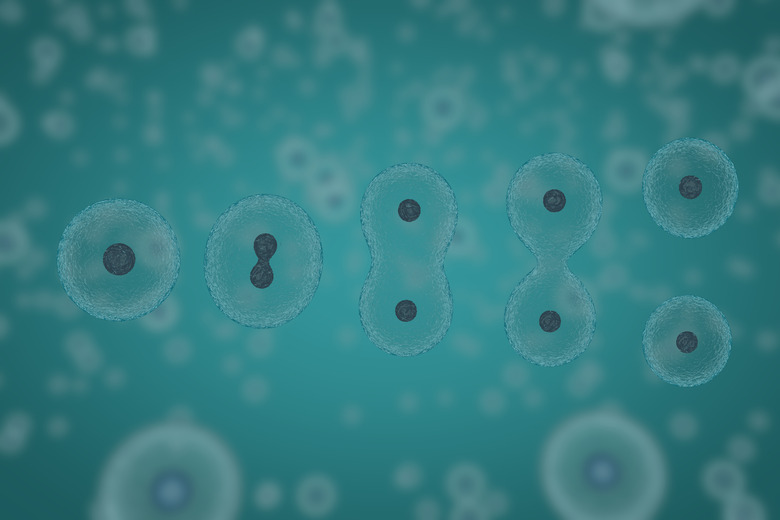List The Steps Of The Cell Cycle In Order
Your body is made up of around 37 trillion tiny cells, which can only be seen under a microscope. Each cell formed from an existing cell — and in turn — it forms new cells. Called the cell cycle or cell-division cycle, each step in this cycle depends on whether the cell has a nucleus or not. Bacteria don't have a cell nucleus, but other cells like eukaryotes do.
TL;DR (Too Long; Didn't Read)
In cells without a nucleus, like bacteria, the cell cycle is called binary fission. In cells with a nucleus, like eukaryotes, the in-order steps in the cell cycle consist of interphase, mitosis and cytokinesis.
Bacteria Cell Cycle
Bacteria Cell Cycle
In bacteria, which lack a cell nucleus, the cell cycle is known scientifically as bacterial binary fission. The bacterial chromosome is in a part of the cell called the nucleoid. Copying of DNA starts at the origin of replication on the chromosome. The origin and the new, copied origins then move toward opposite ends of the cell, taking the rest of the chromosomes with them.
The cell gets longer as this happens, contributing to the separation of the new chromosomes. After copying the whole chromosome, and the replication enzymes meet leaving the center of the cell clear, the cytoplasm divides. The membrane squeezes inward and a new dividing wall, called a septum, forms down the middle of the cell. The septum splits in two, creating two new bacterial cells.
Interphase Consists of Three Stages
Interphase Consists of Three Stages
During interphase, the cell grows, accumulating nutrients needed for mitosis, preparing it for cell division and duplicating its DNA. Interphase contains three phases: G1, S and G2, whereby G stands for gap and S stands for synthesis. The G1 and G2 phases involve growth and preparation for later changes. For example, protein synthesis happens during G1 to increase the amount of cytosol — the liquid containing the cell's proteins — in the cell. During the synthesis phase, the cell duplicates the DNA in its entire genome. During G2, the cell prepares to enter mitosis.
Mitosis -- Five Active Stages
Mitosis — Five Active Stages
During mitosis, the chromosomes separate. A cell divides, creating two genetically identical daughter cells. Mitosis itself consists of five active steps or phases: prophase, prometaphase, metaphase, anaphase and telophase. During prophase, the chromosomes inside the cell's nucleus form tight structures. In prometaphase, the nuclear membrane falls apart and the mitotic spindle connects with the chromosomes. During metaphase, microtubules organize chromosomes in a line along the cell's equator.
The centrosomes — the location where spindle fibers develop during division — then prepare to separate the sister chromatids. In anaphase, the microtubules pull the sister chromatids apart and toward opposite poles of the cell, forming separate chromosomes. These reach the mitotic spindle during telophase and a nuclear membrane forms around each set of chromosomes, creating two separate nuclei inside the same cell.
Cytokinesis -- The Physical Process
Cytokinesis — The Physical Process
Cytokinesis, the physical process of cell division, happens at the same time as mitosis, beginning during anaphase and continuing through telophase. During cytokinesis, the chromosomes and cytoplasm separate into two new daughter cells. Cytokinesis occurs differently in animal and plant cells. In animal cells, the plasma membrane of the parent cell pinches inward along the cell's equator until two daughter cells form. In plant cells, a cell plate forms along the equator of the parent cell. A new plasma membrane and cell wall form along each side of the cell plate.
Cite This Article
MLA
Gillespie, Claire. "List The Steps Of The Cell Cycle In Order" sciencing.com, https://www.sciencing.com/list-steps-cell-cycle-order-18494/. 11 July 2019.
APA
Gillespie, Claire. (2019, July 11). List The Steps Of The Cell Cycle In Order. sciencing.com. Retrieved from https://www.sciencing.com/list-steps-cell-cycle-order-18494/
Chicago
Gillespie, Claire. List The Steps Of The Cell Cycle In Order last modified March 24, 2022. https://www.sciencing.com/list-steps-cell-cycle-order-18494/
